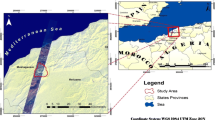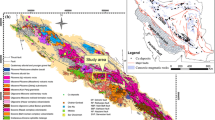Abstract
Remote sensing technology and its terrestrial components are more useful than classical geological investigation in mineral exploration and mapping the hydrothermal alteration areas and help to investigate larger areas in short time. Intrusive and volcanic rocks, namely Kösedag syenite and Karatas volcanics in Kösedag (Zara) area shows argillic alteration zones. Two different test area were chosen and sampled for mineralogical studies. XRD-CF investigations showed that kaolinite and illite are the dominant clay minerals in test areas of A and B respectively. The spectroradiometer measurements were carried out 5 times on different surfaces of clayey samples with self-illuminated contact-probe lens within the wavelength range of 350-2500 nm. The spectroradiometer measurements used as endmember were resampled to ASTER short wave infrared (SWIR) bandwidths. Band ratio, principal component and decorrelation stretching analysis were performed to visualize the distribution of clay minerals. In spectral classification method, matched filtering (MF) was used for integrating the satellite image and spectroradiometer measurement data. It was concluded that co-interpretations of the band ratio, principal component, decorrelation stretching analysis, MF results and geological map are very useful in determining, classifying and mapping of the argillic alteration zones related to hydrothermal processes on ASTER image and they seem to be very useful to identify the target areas for mineral exploration.
Similar content being viewed by others
References
Abdeen, M.M., Allison, T.K., Abdelsalam, M.G., Stern, R.J. (2001) Application of ASTER band-ratio images for geological mapping in arid regions; the Neoproterozoic Allaqi Suture, Egypt. Abstract with Program, Geol. Soc. Amer., v.3(3), pp.289.
Abrams, M. (2000) The Advanced Spaceborne Thermal Emission and Reflection Radiometer (ASTER): data products for the high spatial resolution imager on NASA’s Terra platform. Internat. Jour. Remote Sensing, v.21, pp.847–859.
Abrams, M., Hook, S.J. (1995) Simulated ASTER data for geologic studies IEEE Trans. Geosci. Remote Sensing, v.33(3), pp.692–699.
Abrams, M.J., Brown, D., Lepley, L., Sadowski, R. (1983) Remote sensing for porphyry copper deposits in southern Arizona. Econ. Geol., v.78, pp.591–604.
Basibüyük, Z. (2006) Hydrothermal alteration mineralogy-petrography and geochemistry of Eocene volcanics: an example from quadrangle of Zara-Imranli-Susehri-Serefiye (Northeast of Sivas, Central Eastern Anatolia, Turkey). PhD thesis, Sivas-Turkey, Cumhuriyet University, Institute of Science, pp.269
Bedell, R.L. (2001) Geological mapping with ASTER satellite: new global satellite data that is a significant leap in remote sensing geologic and alteration mapping. Spec. Publ., Geol. Soc. Nevada, v.33, pp.329–334.
Bedini, E., Van Der Meer, F., Van, F. (2009) Ruitenbeek Use of HyMap imaging spectrometer data to map mineralogy in the Rodalquilar caldera, southeast Internat. Jour. Remote. Sens., v.30 (2), pp.327–348.
Bennett, S.A., Atkinson, W.W., Kruse, F.A. (1993) Use of Thematic Mapper imagery to identify mineralization in the Santa Teresa district, Sonara, Mexico. Internat. Geol. Rev., v.35, pp.1009–1029.
Blewitt, G. (1993) Advances in Global Positioning System technology for 333 geodynamics investigations. In: Contributions of Space Geodesy to Geodynamics: 334 Technology, Ed. by D.E. Smith and D.L. Turcotte,, Pub. by American 335 Geophysical Union (Geodynamics Series), Washington DC, v.25, pp.
Boztug, D. (2008) Petrogenesis of the Kösedag Pluton, Susehri-NE Sivas, East-Central Pontides, Turkey. Turkish Jour. Earth Sci., v.17, pp.241–262.
Brindley, G.W. (1980). Quantitative X-ray mineral analysis of clays: In: Crystal Structures of Clay Minerals and Their X-ray Identification, G.W. Brindley and G. Brown (eds.), Mineralogical Society, London, pp.411–438.
Crosta, A., De Souza Filho, C., Azevedo, F., Brodie, C. (2003) Targeting key alteration minerals in epithermal deposits in Patagonia, Argentina, using ASTER imagery and principal component analysis. Internat. Jour. Remote Sensing, v.24(21), pp.4233–4240.
Di Tommaso, I., Rubinstein, N. (2007) Hydrothermal alteration mapping using ASTER data in the Infiernillo porphyry deposit, Argentina Ore Geol. Rev., v.32, pp.275–290.
Ducart, D.F., Crosta, A.P., Filio, C.R.S. (2006). Alteration mineralogy at the Cerro La Mina epithermal prospect, Patagonia, Argentina: field mapping, short-wave infrared spectroscopy, and ASTER images. Econ. Geol., v.101, pp.981–996.
Efe, A., Gökce, A. (1999). Geology and fluid inclusion studies of the Maden Village (Imranli-Sivas) Pb-Zn deposits. Bulletin of faculty of engineering of Cumhuriyet University, Serie S-Earth Sciences, v.16, pp.29–38
Eyuboglu, Y. (2010) Late Cretaceous high-K volcanism in the eastern Pontides orogenic belt, and its implications for the geodynamic evolution of NE Turkey. Internat. Geol. Rev., v.52(2–3), pp.142–186.
Eyuboglu, Y., Chung, S.L., Santosh, M., Dudas, F.O., Akaryali, E. (2011a) Transition from shoshonitic to adakitic magmatism in the Eastern Pontides, NE Turkey: implications for slab window melting. Gondwana Res., v.19, pp.413–429.
Eyuboglu, Y., Santosh, M., Bektas, O., Ayhan, S. (2011d) Arc magmatism as a window to plate kinematics and subduction polarity: example from the Eastern Pontides belt, NE Turkey. Geosci. Front., v.2(1), pp.49–56.
Eyuboglu, Y., Santosh, M., Chung, S.L. (2011c) Crystal fractionation of adakitic magmas in the crust-mantle transition zone: petrology, geochemistry and U–Pb zircon chronology of the Semi adakites, Eastern Pontides, NE Turkey. Lithos, v.121, pp.151–166.
Eyuboglu, Y., Santosh, M., Chung, S.L. (2011e) Petrochemistry and U–Pb ages of adakitic intrusions from the Pulur massif (Eastern Pontides, NE Turkey): Implications for slab roll-back and ridge subduction associated with Cenozoic convergent tectonics in eastern Mediterranean. Jour. Geol., v.119, pp.394–417.
Eyuboglu, Y., Santosh, M., Dudas, F.O., Chung, S.L., Akaryali, E. (2011b). Migrating magmatism in a continental arc: geodynamics of the Eastern Mediterranean revisited. Jour. Geodynamics, v.52, pp.2–15.
Eyuboglu, Y., Santosh, M., Yi, K., Bektas, O., Kwon, S. (2013a) Discovery of Miocene adakitic dacite from the Eastern Pontides Belt and revised geodynamic model for the late Cenozoic Evolution of eastern Mediterranean region. Lithos, v.146–147, pp.218–232.
Eyuboglu, Y., Santosh, M., Dudas, F.O., Akaryali, E., Chung, S.L., Akdag, K., Bektas, O. (2013b) The nature of transition from adakitic to non-adakitic magmatism in a slab-window setting: a synthesis from the eastern Pontides, NE Turkey. Geosci. Front., v.4, pp.353–375.
Fujisada, H. (1995). Design and performance of ASTER instrument. Proc. SPIE, v.2583, pp.16–25.
Gabr, S., Ghulam, A., Kusky, T. (2010) Detecting areas of high-potential gold mineralization using ASTER data. Ore Geol. Rev., v.38, pp.59–69.
Gad, S., Kusky, T. (2007) ASTER spectral rationing for lithological mapping in the Arabian–Nubian shield, the Neoproterozoic Wadi Kid area, Sinai, Egypt. Gondwana Res., v.11, pp.326–335.
Gürsoy, Ö. (2016) Determining the most appropriate classification methods for water quality, IOP Conference Series Earth and Environmental Science, v.44(2),pp.022–038.
Gürsoy, Ö., Kaya, S. (2016) Detecting of Lithological Units by Using Terrestrial Spectral Data and Remote Sensing Image. Jour. Indian Soc. Remote Sensing, v.1,pp.1–11
Gürsoy, Ö., Kaya, S., Çakir, Z., Tatar, O., Canbaz, O. (2017) Determining Lateral Offsets of Rocks Along The Eastern Part of The North Anatolian Fault Zone (Turkey) Using Spectral Classification of Satellite Images and Field Measurements. Geomatics, Natural Hazards and Risk, pp.1–13.
Hewson, R.D., Cudahy, T.J., Huntington, J.F. (2001) Geologic and alteration mapping at Mt Fitton, South Australia, using ASTER satellite-borne data. Internat. Geosci. Remote Sensing Symposium 2, pp.724–726.
Hewson, R.D., Cudahy, T.J., Mizuhiko, S., Ueda, K., Mauger, A.J. (2005) Seamless geological map generation using ASTER in the Broken Hill-Curnamona province of Australia. Remote Sensing Environ., v.99, pp.159–172.
Hunt, G.R. (1977) Spectral signatures of particulate minerals in the visible and near infrared. Geophysics, v.42, pp.501–513.
Iwasaki, A, Tonooka, H. (2005) Validation of a crosstalk correction algorithm 371 for ASTER/SIWR. IEEE Trans. Geosci. Remote Sensing, v.43, pp. 2747–2751.
Mustard, J.F., Sunshine, M.J. (1998) Spectral analysis for earth science: investigations using remote sensing data, In: Rencz, Andrew (Ed.), 3rd ed. Remote Sensing for the Earth Sciences: Manual for Remote Sensing, v.3, pp.251–306.
Ninomiya, Y., FU, B. (2003) Extracting lithological information from ASTER multispectral thermal infrared data in the northeastern Pamirs. Xinjiang Geology, v.21, pp.22–30.
Okada, K., Ishii, M. (1993) Mineral and lithological mapping using thermal infrared remotely sensed data from ASTER simulator. International Geosciences and Remote Sensing symposium “Better Understanding of Earth Environment”, v.93, pp.126–128.
Okay, A., Tüysüz, O. (1999) Tethyan sutures of northern Turkey. Geol. Soc. London, Spec. Publ., v.156, pp.475–515.
Pour, B.A., Hashim, M., Marghany, M. (2011) Using spectral mapping techniques on short wave infrared bands of ASTER remote sensing data for alteration mineral mapping in SE Iran. Int. Jour. Phys. Sci., v.6(4), pp.917–929.
Rockwell, B.W., Hofstra, A.H. (2008) Identification of quartz and carbonate minerals across northern Nevada using ASTER thermal infrared emissivity data implications for geologic mapping and mineral resource investigations in well-studied and frontier areas. Geosphere, v.4(1), pp.218–246.
Rowan, L. C., Schmidt, R. G., Mars, J. C. (2006). Distribution of hydrothermally altered rocks in the Reko Diq, Pakistan mineralized area based on spectral analysis of ASTER data. Remote Sensing Environ., v.104, pp.74–87
Rowan, L., Hook, S.J., Abrams, M.J., Mars, J.C. (2003) Mapping hydrothermally altered rocks at Cuprite, Nevada, using the Advanced Spaceborne thermal emission and reflection radiometer (ASTER), a new satelliteimaging system. Econ. Geol. Bull. Soc. Econ. Geol., v.98(5), pp.1019–1027.
Rowan, L.C., Mars, J.C. (2003) Lithologic mapping in the Mountain Pass, California area using Advanced Spaceborne Thermal Emission and Reflection Radiometer (ASTER) data. Remote Sensing Environ., v.84, pp. 350–366.
Rowan, L.C., Mars, J.C., Simpson, C.J. (2005). Lithologic mapping of the Mordar, NT, Australia, ultramaûc complex by using Advanced Spaceborne Thermal Emission and reûection Radiometer (ASTER) data. Remote Sensing Environ., v.99, pp.105–126.
Tangestani, M.H., Moore, F. (2001) Comparison of three principal component analysis techniques to porphyry copper alteration mapping: a case study, Mei-duk area, Kerman, Iran. Canadian Jour. Remote Sensing, v.27, pp. 176–181.
Thome, K., Baggar, S., Slater, P. (2001) Effects of assumed solar spectral 464 irradiance on intercomparisons of earth-observing sensors. Proceedings SPIE, v.4540, pp. 260–269.
Velosky, J.C., Stern, R.J., Johnson, P.R. (2003) Geological control of massive sulfide mineralization in the Neoproterozoic Wadi Bidah shear zone, southwestern Saudi Arabia, inferences from orbital remote sensing and field studies. Precambrian Res., v.123(2–4), pp.235–247.
Yalçin, H. and Bozkaya, Ö. (2002). Alteration mineralogy and geochemistry of Upper Cretaceous volcanics around Hekimhan (Malatya): A sample of sea water-rock interaction. Bulletin of faculty of engineering of Cumhuriyet University, Serie S-Earth Sciences, pp.81–98.
Yamaguchi, Y., Fujisada, H., Tsu, H., Sato, I., Watanabe, H., Kato, M., Kudoh, M., Kahle, A.B., Pniel, M. (2001) ASTER early image evaluation. Adv. Space Res., v.28(1),pp. 69–76.
Yamaguchi, Y., Kahle, A.B., Tsu, H., Kawakami,T., Pniel, M. (1998) Overview of Advanced Spaceborne Thermal Emission and Reflection Radiometer (ASTER). IEEE Trans. Geosci. Remote Sensing, v.36, pp.1062–1071.
Author information
Authors and Affiliations
Corresponding author
Rights and permissions
About this article
Cite this article
Canbaz, O., Gürsoy, Ö. & Gökce, A. Detecting Clay Minerals in Hydrothermal Alteration Areas with Integration of ASTER Image and Spectral Data in Kösedag-Zara (Sivas), Turkey. J Geol Soc India 91, 483–488 (2018). https://doi.org/10.1007/s12594-018-0882-1
Received:
Accepted:
Published:
Issue Date:
DOI: https://doi.org/10.1007/s12594-018-0882-1




